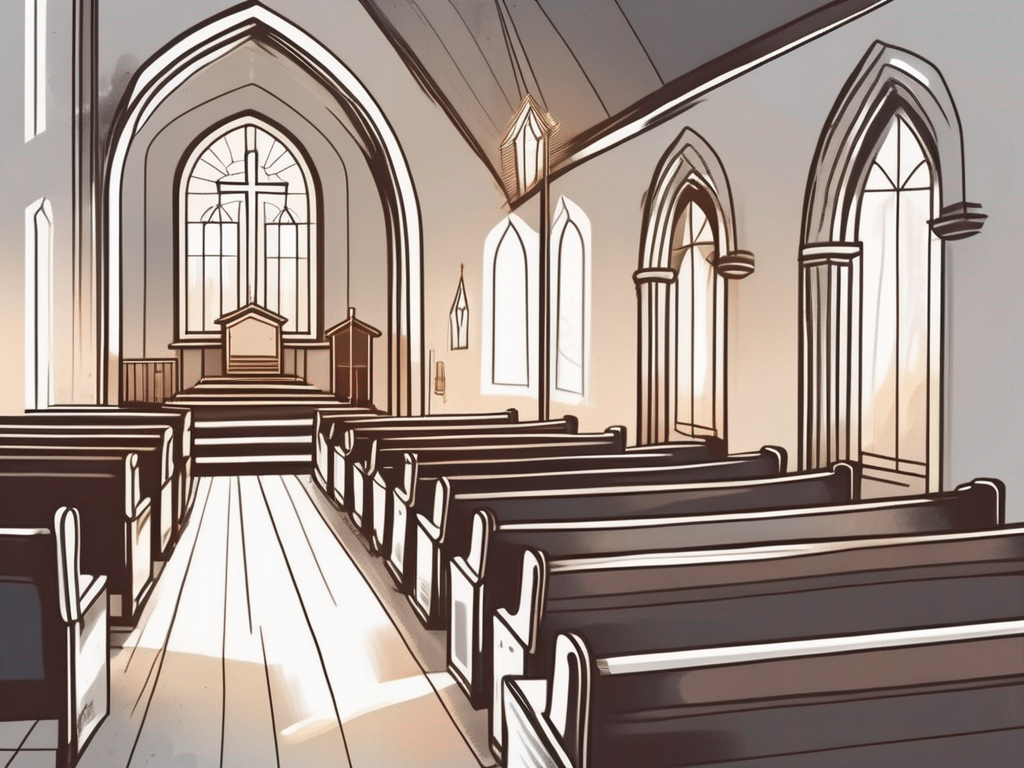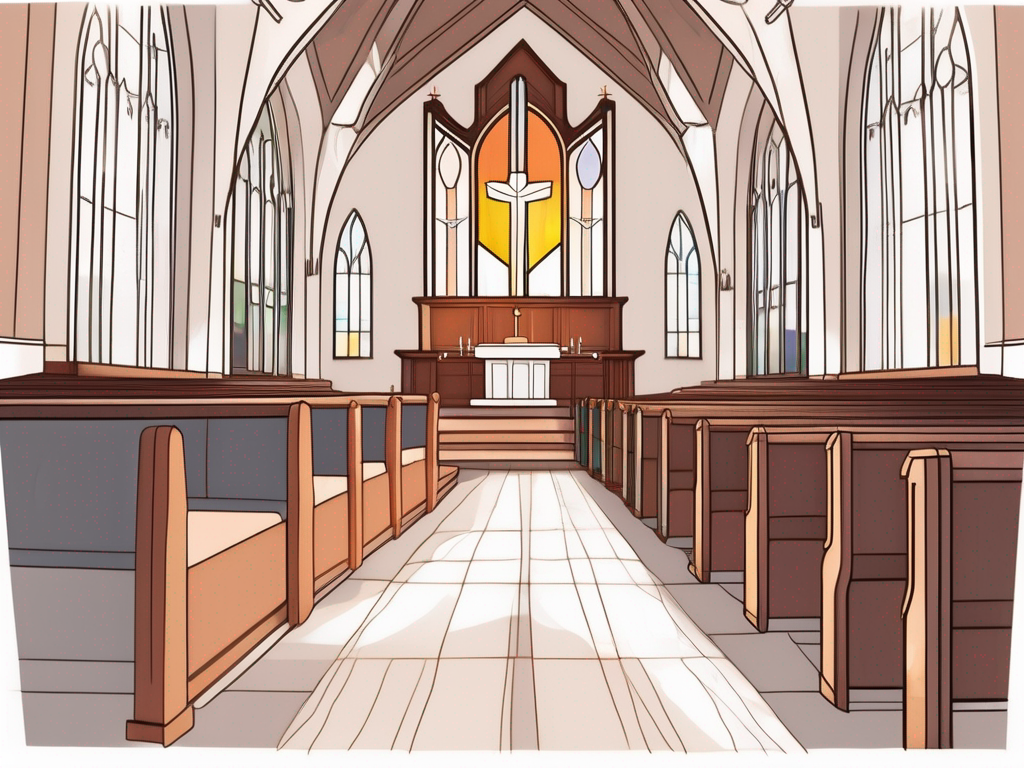Christianity, one of the world’s largest religions, is known for its diverse customs and practices. One aspect that stands out is its place of worship. In this article, we will explore the concept of worship in Christianity, the various types of worship places, the architecture of these places, their role in the community, and the rituals and ceremonies performed within them.
Understanding the Concept of Worship in Christianity
Before diving into the physical places of worship, it is crucial to grasp the significance of worship in Christianity. Worship, from a biblical perspective, goes beyond attending a service or singing hymns. It involves a deep reverence and honor for God, expressing adoration, thanksgiving, and seeking a spiritual connection.
Worship in Christianity is not a mere ritual or obligation; it is a heartfelt response to God’s love and grace. It is an opportunity for believers to express their devotion and surrender to the Almighty. Through worship, Christians acknowledge God’s sovereignty and recognize their dependence on Him.
The Biblical Perspective of Worship
In the Bible, worship is portrayed as a personal and communal act. It is not limited to a specific location but can occur anywhere believers gather to honor God. The central focus of worship is the relationship between individuals and God, fostering a deeper understanding of faith.
Throughout the Old and New Testaments, various forms of worship are described. From the psalms of David to the prayers of Paul, worship takes on different expressions. It can involve singing, dancing, praying, reading scripture, and even acts of service and sacrifice.
One example of worship in the Bible is found in the book of Psalms. King David, known for his musical abilities, composed numerous psalms that were used in worship gatherings. These psalms express a range of emotions, from joy and praise to lament and supplication. They serve as a guide for believers to express their hearts to God in times of celebration and hardship.
The Role of Worship in a Christian’s Life
Christian worship plays a vital role in the lives of believers. It allows them to grow spiritually, experience God’s presence, and find solace and guidance. Through worship, Christians can strengthen their faith and develop a sense of belonging within a community of like-minded individuals.
Worship is not limited to a specific time or place. It can happen in a church building, a home, or even in nature. The act of worship is not confined to a set of rituals but is a lifestyle of surrender and devotion to God.
Furthermore, worship is not only about the individual’s relationship with God but also about the community of believers. It is an opportunity for believers to come together, support one another, and encourage each other in their faith journey. In worship gatherings, believers can find comfort, inspiration, and a sense of unity as they worship God together.
In conclusion, worship in Christianity is not a superficial or obligatory act. It is a deeply meaningful and transformative experience that allows believers to connect with God, express their devotion, and grow in their faith. Whether through music, prayer, scripture reading, or acts of service, worship is an integral part of the Christian life.
The Different Types of Christian Worship Places
Christian worship takes place in various settings, each with its unique characteristics and purposes. Let’s explore some of these worship places.
The Church: A Central Place of Worship
The church, also known as a house of worship, is the most common and traditional place for Christian gatherings. It serves as a spiritual hub where believers come together to pray, worship, learn, and receive pastoral guidance. Churches often display intricate architectural designs and are known for their beautiful stained glass windows.
When you step into a church, you are greeted by a sense of reverence and tranquility. The air is filled with the soft whispers of prayers and the gentle melodies of hymns. The pews, arranged neatly in rows, provide a place for worshippers to sit and reflect on their faith.
Churches are not only places of worship but also centers of community. They host various activities and events that bring people together, such as Bible studies, youth groups, and community outreach programs. These gatherings foster a sense of belonging and strengthen the bonds between believers.
Cathedrals: The Grandeur of Christian Worship
A cathedral, with its awe-inspiring grandeur, is a significant worship place in Christianity. These monumental structures feature high ceilings, ornate decorations, and magnificent organs. Cathedrals hold a special religious and cultural importance and often serve as the seat of a bishop.
Walking into a cathedral is like stepping into a different world. The sheer size and beauty of the space leave you in awe. Sunlight streams through the stained glass windows, casting vibrant colors on the stone floors. The echoes of footsteps reverberate throughout the vast expanse, creating a sense of reverence and solemnity.
Cathedrals are not only places of worship but also architectural marvels. The intricate details carved into the walls and ceilings tell stories of faith, history, and artistic expression. The grand organs, with their majestic pipes, fill the space with music that resonates deep within your soul.
Chapels and Their Significance
Chapels, smaller than churches and cathedrals, provide a more intimate setting for worship. They are often found in schools, hospitals, military installations, and other community spaces. Chapels offer a place for prayer and reflection, providing comfort and solace in times of need.
When you enter a chapel, you are enveloped in a sense of peace and serenity. The soft lighting and simple decor create an atmosphere conducive to quiet contemplation. The intimate size of the chapel allows for a more personal connection with God, as if you are having a conversation with Him in a sacred space.
Chapels hold a special significance in certain institutions. In hospitals, they provide a haven for patients and their families to find solace and seek spiritual support during times of illness or loss. In schools, chapels serve as a place for students to gather and strengthen their faith as they navigate the challenges of education and personal growth.
Overall, Christian worship places come in various forms, each offering a unique experience and fulfilling different needs. Whether it’s the grandeur of a cathedral, the warmth of a church, or the intimacy of a chapel, these worship places serve as sacred spaces where believers can connect with God and find spiritual nourishment.
The Architecture of Christian Worship Places
Christian worship places are not only sanctuaries for spiritual connection but also architectural marvels. They are spaces that have been carefully designed and constructed to inspire awe and reverence in those who enter their doors. The architecture of these places of worship is a testament to the deep-rooted faith and devotion of the Christian community.
One of the most fascinating aspects of Christian architectural design is the symbolism that is infused into every element of the structure. From the cross on the steeple to the intricately carved motifs, every detail carries a deeper meaning. For example, the shape of the cross represents Jesus’ sacrifice and serves as a constant reminder of the central tenets of the Christian faith. The stained glass windows, with their vibrant colors and intricate designs, depict biblical stories and themes, allowing worshippers to visually connect with the teachings of the Bible.
As we delve deeper into the evolution of Christian worship architecture, we discover a rich tapestry of styles and influences that have shaped these sacred spaces over the centuries. The early Christian worship places were characterized by simple basilica-style buildings, which were influenced by the architecture of the Roman Empire. These structures featured a rectangular plan, with a central nave and side aisles, creating a sense of unity and community among the worshippers.
However, as Christianity spread throughout Europe, new architectural styles emerged, each reflecting the cultural and historical influences of the time. The Gothic period, for example, saw the rise of towering cathedrals with pointed arches, ribbed vaults, and flying buttresses. These architectural elements not only allowed for the construction of larger and more elaborate buildings but also created a sense of verticality and transcendence, symbolizing the connection between heaven and earth.
The Renaissance period brought a renewed interest in classical architecture, with Christian worship places incorporating elements such as domes, columns, and symmetrical designs. The grandeur and harmony of these structures were intended to evoke a sense of divine order and beauty, reflecting the belief in the perfection of God’s creation.
In more recent times, modern designs have emerged, reflecting the changing needs and sensibilities of the Christian community. These worship places often embrace contemporary architectural styles, incorporating elements of minimalism, sustainability, and inclusivity. They strive to create spaces that are welcoming and accessible to all, while still maintaining a sense of sacredness and reverence.
As we explore the architecture of Christian worship places, we are reminded of the profound impact that these structures have on the spiritual experience of worshippers. They are not merely buildings but sacred spaces that inspire and uplift, inviting individuals to connect with something greater than themselves. Whether it is the soaring arches of a Gothic cathedral or the simplicity of a modern chapel, these architectural marvels continue to be a testament to the enduring power of faith and the human desire for transcendence.
The Role of Christian Worship Places in Community
Christian worship places extend their impact beyond spiritual gatherings. They have a profound influence on the surrounding community.
Fostering Fellowship and Unity
Worship places serve as a meeting point for the Christian community, fostering fellowship and unity. They provide a space where individuals can connect, support each other, and engage in activities that promote communal well-being.
Within these worship places, various groups and organizations are formed to cater to the diverse needs and interests of the community. These groups range from Bible study groups, prayer circles, and youth ministries to support groups for individuals facing specific challenges such as addiction or grief. Through these groups, members of the community can find a sense of belonging and support, strengthening the bonds of fellowship and unity.
Furthermore, worship places often organize events and gatherings that bring the community together. These can include picnics, potlucks, and festivals celebrating religious holidays. Such events provide an opportunity for people to interact, share meals, and engage in conversations that deepen their relationships. The sense of togetherness and camaraderie fostered by these gatherings extends beyond the walls of the worship place and permeates the entire community.
Serving as a Hub for Charitable Activities
Many Christian worship places actively engage in charitable endeavors. They organize food drives, clothing donations, and other initiatives to support the less fortunate in society. These efforts help create a sense of compassion and service within the community.
Through their charitable activities, worship places become a hub for community members to come together and make a positive impact. Volunteers from the congregation often dedicate their time and resources to serve those in need. They may organize soup kitchens, where hot meals are provided to the homeless, or partner with local organizations to provide shelter for individuals experiencing homelessness. These initiatives not only address immediate needs but also strive to empower individuals to break free from cycles of poverty and despair.
Moreover, worship places may collaborate with other community organizations to tackle larger social issues. They may join forces with local schools to provide educational resources for underprivileged children or partner with healthcare providers to offer free medical clinics. By leveraging their resources and networks, worship places play a vital role in addressing systemic challenges and advocating for justice and equality within the community.
The Rituals and Ceremonies in Christian Worship Places
Christian worship places are filled with rituals and ceremonies that hold deep meaning for believers.
Sunday Services and Their Importance
Sunday services are the cornerstone of Christian worship. They typically involve prayer, singing hymns, biblical teachings, and partaking in the Eucharist or Communion. These services create a sacred space for corporate worship and spiritual nourishment.
Sacraments and Rites Performed in Churches
Christian worship places are where sacraments and rites are administered. Baptism, confirmation, marriage, and funerals are sacred ceremonies that mark significant milestones in a Christian’s life.
In conclusion, Christianity’s place of worship encompasses more than just physical structures. It represents the faithful’s journey to connect with God, a communal gathering for spiritual growth, and a hub for benevolent initiatives. The architecture of these worship places reflects the rich symbolism and artistic heritage of the faith. The rituals and ceremonies conducted within these spaces provide believers with a profound sense of spiritual fulfillment. Whether individuals gather in grand cathedrals or humble chapels, the essence of worship remains the same—a profound expression of faith and devotion.












